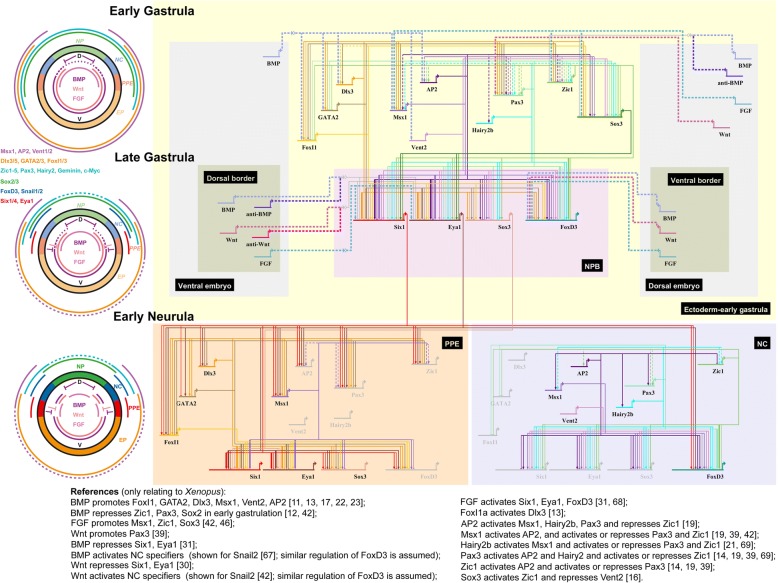Fig. 6.
Gene regulatory network (GRN) for NPB development in Xenopus laevis. Greyed out genes represent those inactive in a particular cell population (e.g. Zic1 in the PPE). All interactions shown are based on functional studies and may be direct or indirect. Solid lines indicate relationships established in the present study or in [15], whereas hatched lines indicate relationships established in previous studies referenced below. Arrows indicate activation. Bars show repression. Thick lines indicate relationships verified in loss of function (and often also in gain of function) experiments, while thin lines indicate relationships only supported by gain of function experiments. Signaling pathways are shown in extra thick lines. Often there is experimental evidence to support both activation and repression of genes by upstream TFs. Further studies are needed to elucidate the interactions determining these context-dependent effects. In the absence of functional data, temporal changes of regulatory relationships are proposed here based on changing expression patterns. Panels on the left depict idealized cross sections through cranial region of Xenopus embryos showing TF distribution at three stages of development (D, dorsal; V, ventral) (modified from [2]). Hatched lines indicate downregulation of expression. Pax3 and c-Myc TFs only get upregulated in the lateral part of the turquoise domain during gastrulation. Presumptive neural plate (NP), neural crest (NC), preplacodal ectoderm (PPE), and epidermis (EP) are shown as fate map for gastrula stages (faint colors) and as specified territories for the early neurula (strong colors). BMP, Wnt, and FGF signaling is shown by colored lines inside the schematized embryo, with graded BMP activity and approximate position of sources of BMP inhibitors and Wnt inhibitors indicated (bars). During gastrulation, many TFs become increasingly dorsally (turquoise and green) or ventrally (orange and pink) restricted, and the region of overlap decreases. NC (blue) and PPE (red) specifiers become confined to non-overlapping territories in the neural (turquoise) and non-neural (orange) ectoderm at the end of gastrulation. See text for details

